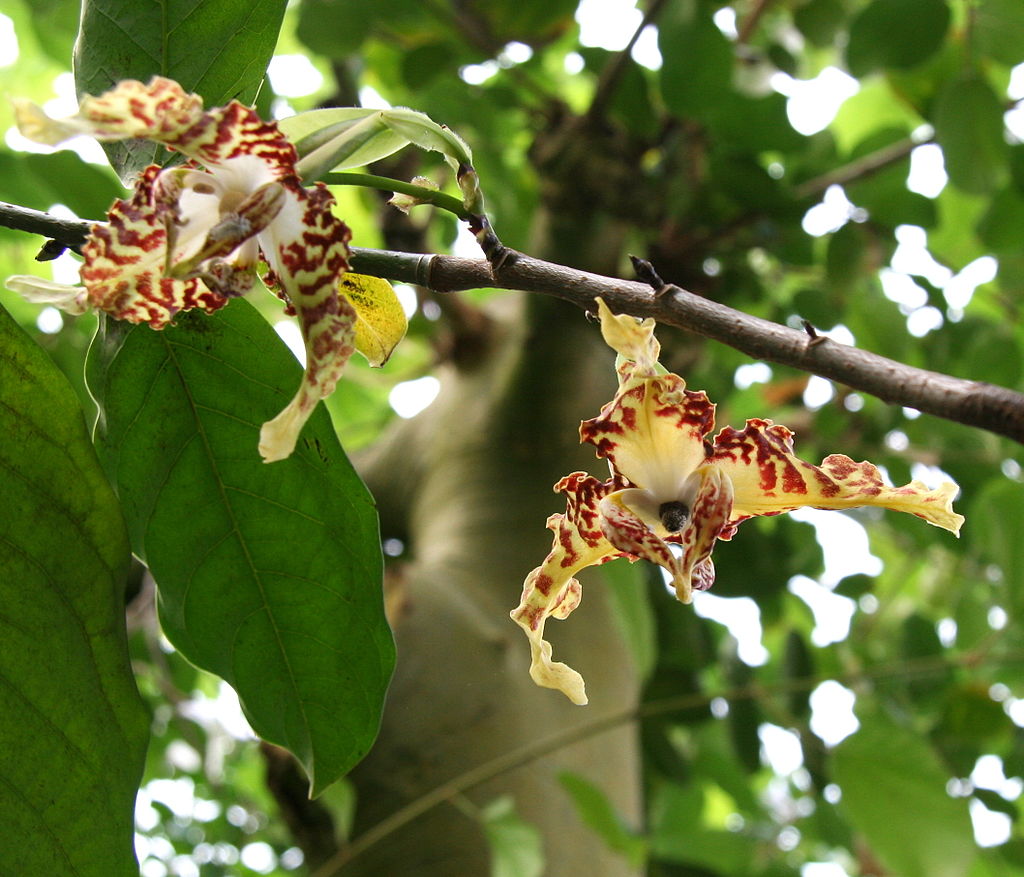Monodora tenuifolia

|
|
Monodora tenuifolia Common Names: Calabash Nutmeg, African Nutmeg, False
Nutmeg Scientific
Classification Kingdom: Plantae Clade: Tracheophytes Clade: Angiosperms Order: Magnoliales Family: Annonaceae Genus: Monodora Species: M. tenuifolia Synonyms: Monodora tenuifolia Benth. Morphological Description Monodora tenuifolia is a tropical evergreen tree in the Annonaceae family,
typically growing 20–30 m tall with a trunk diameter up to 60 cm at breast
height. Its key features include: · Bark: Dark grey to greenish, reticulated or striped, with white
lenticels on older branches; young branches green to brown, glabrous (Burkill,
1985). · Leaves: Alternate, narrowly elliptic to ovate, 6–21 cm long, 2–7.5
cm wide, base cuneate, apex acuminate (5–10 mm long), papyraceous to
coriaceous, glabrous, green above, pale below; petioles 2–7 mm long (Keay,
1989). · Flowers: Solitary, pendulous, leaf-opposed, appearing on old branches
before or during leaf flush; pedicels 25–75 mm long, with colorful petals
characteristic of Annonaceae (Burkill, 1985). · Fruit: Subspherical, woody, 10–15 cm in diameter, green turning
brown; seeds numerous, embedded in aromatic white pulp, used as a spice (Keay,
1989). Its distinctive bark and
aromatic seeds set it apart from related species like Monodora myristica (Chukwuma & Uzoma, 2013). Distribution and Habitat Monodora tenuifolia is native to Western Tropical Africa, spanning from Senegal
to Northwest Angola: · Countries: Senegal, Guinea-Bissau, Sierra Leone, Ivory Coast, Ghana,
Nigeria, Cameroon, Angola. It thrives in diverse
habitats including sandy soils of evergreen rainforests, gallery forests along
rivers, deciduous woodlands, and savanna-like environments, typically at
elevations of 0–800 m. It prefers humid, well-drained soils and partial shade
(Burkill, 1985; Keay, 1989). Ethnopharmacology Monodora tenuifolia is a medicinal plant traditionally used in
African medicine for its antimicrobial, anti-inflammatory, antioxidant,
analgesic, and gastroprotective properties. Its seeds, leaves, and bark contain
bioactive compounds such as flavonoids, alkaloids, and tannins, which
contribute to its therapeutic effects. The plant has been used to treat
infections, pain, inflammation, digestive disorders, and metabolic conditions
like diabetes. Additionally, its antioxidant properties may protect against
oxidative stress-related diseases, and preliminary studies suggest potential
liver-protective effects. While traditional usage supports its medicinal
benefits, further research and clinical trials are needed to confirm its
efficacy and safety. · Antioxidant: Seeds in Nigeria combat oxidative stress. Ugwuona et al.
(2017) found methanolic seed extracts (50 mg/kg) inhibited lipid peroxidation
in cooked meat by 60%, linked to flavonoids and phenolics. · Antidiarrheal: Seed decoctions in Cameroon treat diarrhea. Ezenwali et al.
(2009) reported extracts (200 mg/kg) reduced stool frequency in rats by 45%,
due to tannins. · Analgesic: Bark in Ivory Coast relieves headaches and eye pain. Burkill
(1985) notes its use in collyrium for eye troubles, possibly tied to alkaloids. · Anthelmintic: Seeds in Sierra Leone expel worms. Traditional use aligns
with saponin content (Chukwuma & Uzoma, 2013). · Antidepressant: Seed extracts in Nigeria ease stress. Ekeanyanwu
et al. (2015) showed flavonoid-rich fractions (100 mg/kg) increased swimming
time in rats by 35%, suggesting neuroprotective effects. Phytochemicals include
flavonoids (11.7 g/kg), tannins (1.3 g/kg), saponins, alkaloids (13.3 g/kg),
and phenolics, driving its medicinal potential (Chukwuma & Uzoma, 2013;
Ugwuona et al., 2017). ⚠ Toxicity Profile: No acute toxicity in rats at 5,000 mg/kg of seed extract over 48
hours, but high doses reduced liver enzymes non-significantly, suggesting
potential mild hepatotoxicity. Caution advised in prolonged use due to limited
chronic toxicity data (Ekeanyanwu et al., 2015). Additional Uses · Nutritional: Seeds used as a spice or supplemental food, though low in
lysine (65.5 g/kg carbohydrate, 82.6 g/kg protein) limits dietary value
(Chukwuma & Uzoma, 2013). · Timber/Fiber: Hardwood for carpentry and fibers for cordage (Keay, 1989). · Ornamental: Planted for its lush foliage and aromatic appeal (Burkill,
1985). References
External Links More Pictures
|
|
| Compounds of Monodora tenuifolia |
|
| References |